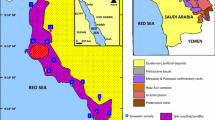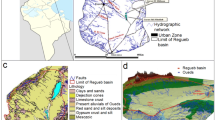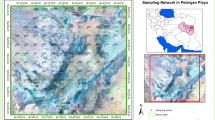Abstract
Al-Kharrar sabkha area is characterized by a distinctive distribution of varied evaporite minerals and microbial activities. The lowest topographic depressions are dominated with primary halite crystals in a high salinity brine (>220‰) or microbial mats at a relatively low salinity value <80‰. As a consequence of desiccation of these pans and in saline mudflat/sandflat areas, gypsum, anhydrite and halite are displacively, inclusively and replacively grown below the sediment surface of the sabkha. Crystallization pressures exerted by these evaporite minerals are very effective in sediment destruction of the sabkha and consequently possible deterioration of the infrastructures of future buildings. In addition, bacterial sulfate reduction corrodes gypsum and results in the formation of carbonate minerals and occasional pyrite. The salinity of sabkha water and brine samples ranges from 21.3 to 141 g/l which is conformable to the concentration values of Cl−. The concentration order of the sabkha water and brine samples is: Na+ > Mg2+ > Ca2+ > K+ or Mg2+ > Na+ > Ca2+ > K+ for cations and Cl− > SO4 2− > HCO3 − for anions. No distinct correlation is observed between the various cations, anions, alkalinity and TDS, with the exception of the positive relation between Cl− and TDS. The dominant brine type for most samples is NaCl or MgNaCl. Mg/Ca ratio in some water samples is high (12.14–23.66) which allows dolomitization of the early deposited carbonate minerals. Most water and brine samples are located in the field of recent or old marine water and of MgCl2 or CaCl2 composition, respectively. The resultant crystallization pressure by evaporite minerals, microbial activity and varied brine compositions are factors that increase the future corrosion for foundations in Al-Kharrar sabkha area.











Similar content being viewed by others
References
Alyamani MS (2007) Effects of cesspool system on groundwater quality of shallow bedrock aquifers in the recharge area of Wadi Fatimah, Western Arabian Shield, Saudi Arabia. J Environ Hydrol 15:1–11
Aref MA, El-Khoriby E, Hamdan MA (2002) The role of salt weathering in the origin of the Qattara Depression, Western Desert, Egypt. Geomorphology 45:181–195
Aref MA, Basyoni MH, Bachmann GH (2014) Microbial and physical sedimentary structures in modern evaporitic coastal environments of Saudi Arabia and Egypt. Facies 60(2):371–388
Bahafzullah AAK, Fayed LA, Kazi A, Al-Saify M (1993) Classification and distribution of the Red Sea coastal sabkha near Jeddah, Saudi Arabia. Carbonates Evaporites 8:23–38
Banat KM, Howari FM, Kadi KA (2005) Water chemical characteristics of the Red Sea coastal sabkhas and associate evaporite and carbonate minerals. J Coast Res 21(5):1068–1081
Basaham AS, Rifaat AE, El-Mamoney MH, El Sayed MA (2009) Re-evaluation of the impact of sewage disposal on coastal sediments of the Southern Corniche, Jeddah, Saudi Arabia. J King Abdulaziz Univ Mar Sci 20:109–126
Basaham AS, El Sayed MA, Ghandour IM, Masuda H (2015) Geochemical background for the Saudi Red Sea coastal systems and its implication for future environmental monitoring and assessment. Environ Earth Sci 74:4561–4570
Basyoni MH (1997) Sedimentological and hydrochemical characteristics of Al-Lith sabkha, Saudi Arabia. J King Abdulaziz Univ Earth Sci 9:75–86
Basyoni MH (2004) Sedimentology, mineralogy and brine chemistry of Rabigh recent Sabkha. Red Sea coast, Saudi Arabia. Sedimentol Egypt 12:1–29
Basyoni MH, Aref MAM (2016) Composition and origin of the sabkha brines, and their environmental impact on infrastructure in Jizan area, Red Sea coast, Saudi Arabia. Environ Earth Sci 75(105):1–17
Behairy AKA, Durgaprasada Rao NVN, El-Shater A (1991) A Siliciclastic coastal sabkha, Red Sea coast, Saudi Arabia. J King Abdulaziz Univ Mar Sci 2:131–141
Bontognali TRR, Vasconcelos CG, Warthmann RF, Bernasconi SM, Dupraz C, Strohmenger CJ, Mckenzie JA (2010) Dolomite formation within microbial mats in the coastal sabkha of Abu Dhabi (United Arab Emirates). Sediment 57:824–844
Charola AE, Pühringer J, Steiger M (2007) Gypsum: a review of its role in the deterioration of building materials. Environ Geol 52:339–352
Cooke RU, Smalley IJ (1968) Salt weathering in deserts. Nature 220:1226–1227
Cornée A, Dickman M, Busson G (1992) Laminated cyanobacterial mats in sediments of solar salt works-some sedimentological implications. Sediment 39:599–612
Cuadrado DG, Carmona NB, Bournod C (2011) Biostabilization of sediments by microbial mats in a temperate siliciclastic tidal flat, Bahia Blanca estuary (Argentina). Sediment Geol 237:95–101
Droppo IG, Ross N, Skafel M, Liss SN (2007) Biostabilization of cohesive sediment beds in a freshwater wave-dominated environment. Limnol Oceanogr 52:577–589
Duncan KE, Gieg LM, Parisi VA, Tanner RS, Tringe SG, Bristow J, Suflita JM (2009) Biocorrosive thermophilic microbial communities in Alaskan north slope oil facilities. Environ Sci Technol 43:7977–7984
El Sayed MA (2002) Factors controlling the distribution and behavior of organic carbon and trace elements in a heavily sewage polluted coastal environment. J King Abdulaziz Univ Mar Sci 13:21–46
El-Hames AS, Al-Ahmadi M, Al-Amri N (2011) A GIS approach for the assessment of groundwater quality in Wadi Rabigh aquifer, Saudi Arabia. Environ Earth Sci 63:1319–1331
Gerbersdorf S, Wieprecht S (2015) Biostabilization of cohesive sediments: revisiting the role of abiotic conditions, physiology and diversity of microbes, polymeric secretion, and biofilm architecture. Geobiology 13:68–97
Gomez-Heras A, Fort R (2007) Patterns of halite (NaCl) crystallisation in building stone conditioned by laboratory heating regimes. Environ Geol 52:259–267
Kaczmarek SE, Sibley DF (2011) On the evolution of dolomite stoichiometry and cation order during high-temperature synthesis experiments: an alternative model for the geochemical evolution of natural dolomites. Sediment Geol 240(1–2):30–40
Konhauser K (2016) Geomicrobial interactions with silicon. In: Ehrlich HL, Newman DK, Kappler K (eds) Ehrlich’s geomicrobiology, 6th edn. CRC Press, Taylor & Frances Group, Boca Raton, FA, USA, pp 237–255
Masoud M (2015) Rainfall-runoff modeling of ungauged Wadis in arid environments (case study Wadi Rabigh—Saudi Arabia). Arab J Geosci 8(5):2587–2606
Okabe S, Odagiri M, Ito T, Satoh H (2007) Succession of sulfur-oxidizing bacteria in the microbial community on corroding concrete in sewer systems. Appl Environ Microbiol 73(3):971–980
Ramsey CR (1986) Geological map of the Rabigh Quadrangle, sheet 22D, Kingdom of Saudi Arabia. Directorate General of Mineral Resources, Jeddah
Satoh H, Odagiri M, Ito T, Okabe S (2009) Microbial community structures and in situ sulfate-reducing and sulfur-oxidizing activities in biofilms developed on mortar specimens in a corroded sewer system. Water Res 43(18):4729–4739
Sharaf MAM (2013) Major elements hydrochemistry and groundwater quality of Wadi Fatimah, West Central Arabian Shield, Saudi Arabia. Arab J Geosci 6:2633–2653
Singh A, Van Hamme JD, Kuhad RC, Parmar N, Ward OP (2014) Subsurface petroleum microbiology. In: Parmar N, Singh A (eds) Geomicrobiology and biogeochemistry, soil biology, vol 39. Springer, Berlin, pp 153–174
Skinner BJ (1966) Thermal expansion. In: Clark SP (ed) Handbook of physical constants, vol 97. Geological Society of America, New York, Memoir, pp 75–96
Taj R, Aref MAM (2015) Hydrochemistry, evolution and origin of brines in supratidal saline pans, south Jeddah, Red Sea coast, Saudi Arabia. Arab J Geosci 8(10):8835–8851
Uchiyama T, Ito K, Mori K, Tsurumaru H, Harayama S (2010) Iron corroding methanogen isolated from a crude-oil storage tank. Appl Environ Microbiol 76:1783–1788
Vasconcelos C, McKenzie JA (1997) Microbial mediation of modern dolomite precipitation and diagenesis under anoxic conditions (Lagoa Vermelha, Rio de Janeiro, Brazil). J Sediment Res 67:378–390
Vigneron A, Alsop EB, Chambers B, Lomans BP, Head IM, Tsesmetzis N (2016) Complementary microorganisms in highly corrosive biofilms from an offshore oil production facility. Appl Environ Microbiol 82(8):2545–2554
Warren J (2000) Dolomite: occurrence, evolution and economically important associations. Earth Sci Rev 52(1–3):1–81
Warren J (2016) Evaporites: a geological compendium. Springer, Berlin, p 1657
Warthmann R, van Lith Y, Vasconcelos C, McKenzie JA, Karpoff AM (2000) Bacterially induced dolomite precipitation in anoxic culture experiments. Geology 28:1091–1094
Wei S, Jiang Z, Liu H, Zhou D, Sanchez-Silva M (2013) Microbiologically induced deterioration of concrete: a review. Braz J Microbiol 44(4):1001–1007
Welch SA, Ullman WJ (1993) The effect of organic acids on plagioclase dissolution rates and stoichiometry. Geoch Cosmochim Acta 57:2725–2736
Winkler EM (1973) Stone: properties, durability in man’s environment. Springer, Berlin, p 230
Wright DT, Wacey D (2005) Precipitation of dolomite using sulphate-reducing bacteria from the Coorong Region, South Australia: significance and implications. Sedimentology 52:987–1008
Youssef M, El-Sorogy A (2016) Environmental assessment of heavy metal contamination in bottom sediments of Al-Kharrar lagoon, Rabigh, Red Sea, Saudi Arabia. Arab J Geosci 9:474
Acknowledgements
We thank the reviewer B. C. Schreiber and the Editor-in-Chief Gunter Doerhoefer for their helpful comments which improved the manuscript. This project was funded by the Deanship of Scientific Research (DSR) at King Abdulaziz University, Jeddah, under Grant No. (425/145/1436). The authors, therefore, acknowledge with thanks DSR for technical and financial support.
Author information
Authors and Affiliations
Corresponding author
Ethics declarations
Conflict of interest
The authors declare that they have no conflict of interest.
Rights and permissions
About this article
Cite this article
Aref, M.A., Taj, R.J. Hydrochemical characteristics of sabkha brines, evaporite crystallization and microbial activity in Al-Kharrar sabkha and their implication on future infrastructures in Rabigh area, Red Sea coastal plain of Saudi Arabia. Environ Earth Sci 76, 360 (2017). https://doi.org/10.1007/s12665-017-6686-6
Received:
Accepted:
Published:
DOI: https://doi.org/10.1007/s12665-017-6686-6




